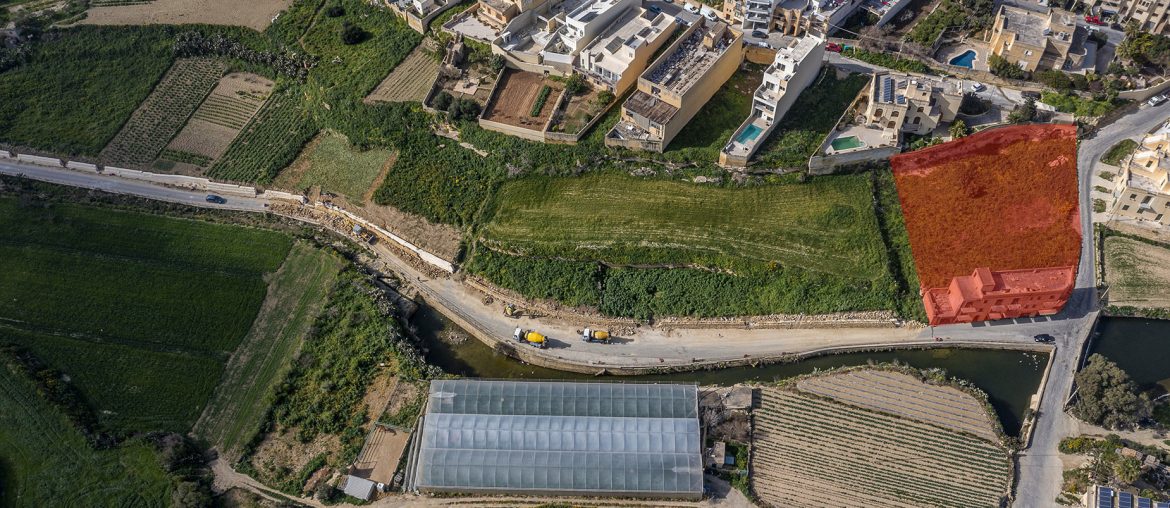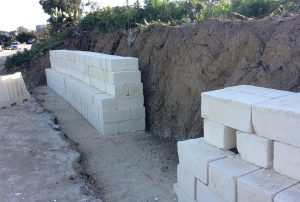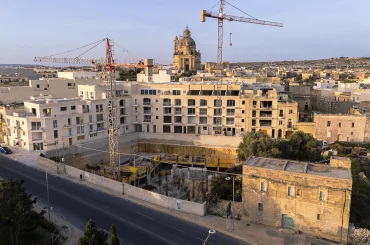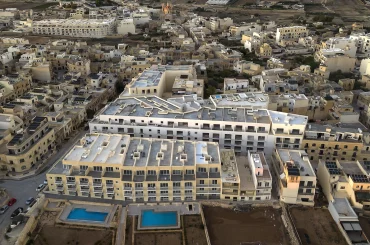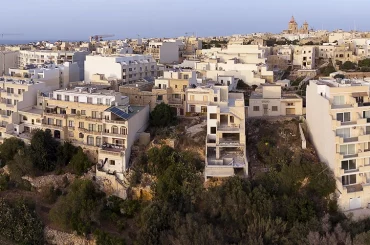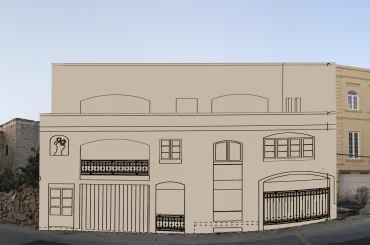Joseph Portelli and his partners appear to be behind a planning application for 54 flats and 42 garages set on six levels at Wied Ta Zejta on the outskirts of Rabat in Gozo, an investigation by this website can reveal. The bulky, dense block would rise over the valley that holds water all year round, near a spot where families take children to feed bread to rabbles of quaking ducks.
Seven years ago, the Rabat Local Council got a Planning Authority permit to turn parts of the road that runs past the proposed block along the valley into a “rural recreation area”, complete with benches and flower beds. But the plan was never implemented.

There have been various attempts to develop the site over the years. These past attempts, all rejected by the Planning Authority, were made by Gozo Consolidated Building Contractors, a company of the business family popularly known as Ta Frenc. The only visible sign of these attempts is a skeletal building that has lain abandoned since it was partially built illegally in the early nineties.
The current application also got off to an unsteady start when an objector wrote to the Planning Authority, as soon as the period for objections opened, that a site notice had “been removed.” He was referring to one of two site notices that disappeared days after it had been affixed to the site; the point of site notices is to announce the application and provide details for anyone wishing to make submissions or objections. Then it reappeared again, nailed to the wall, a day or two after the objector wrote to the Planning Authority.
Click on any of the pictures below to see a sequence of the site notice’s disappearance and reappearance.
The evidence of Portelli’s involvement
The applicant for the block of 54 flats is Thomas Grech, who declared in the application form to be “an owner of the entire site”. But multiple sources and corroborating evidence pointed at property magnate Joseph Portelli and his partners as being behind the proposed development.
A Thomas Grech is listed at a networking online site as Operations Manager of PRA Construction Limited, a company owned by Joseph Portelli, the Agius brothers (Ta Dirjanu), and developer Daniel Refalo. The company is registered at the address of Agius brothers Joseph and Mark, and their company Agius Projects Limited.
Contacted on the phone last Saturday and asked if he denies or confirms that Thomas Grech works for PRA Construction Limited, or that he and his partners (Portelli and Refalo) are involved in this development, Mark Agius did not respond beyond asking to call him during office hours.
Neither did he respond to a question on whether they have purchased the land, or whether this project is in conjunction with Gozo Consolidated Building Contractors.

Site juts from development zone
The block of 54 flats at Wied Ta Zejta sits on a site that protrudes from the main development boundary line. This protrusion was drawn as part of the development zone in the Temporary Planning Schemes of 1988. It remained untouched in the 2006 rationalisation exercise that was intended to address anomalies that occurred in delineating the temporary development boundaries of 1988.

The Gozo Consolidated Building Contractors made various attempts to develop the site along the years. Ignatius Attard on behalf of the company got a permit for garages and two flats in 1994, but then built more than what was permitted and this led to enforcement action – the building has remained an unfinished skeletal shell since then. Attard then applied in 1995 for an “entertainment complex” and then again for a house in 1997 – these two applications were both in turn rejected.

The present application for 54 flats, sitting on the entire extension or protrusion of the development zone, falls within the development zone.
Yet it is a sensitive site at the side of a valley. The height of the 54-flat block – 4-5 storeys above ground – is bound to generate opposition. Other potential issues include its density, and the excavation for underground garages at the side of the valley.
It is not known why previous applications on the site were refused, including the application in 1997 that was just for a house.
Works on road along valley
In the road that runs along the valley, which would be the main access road to the block of flats, a contractor assigned by the Ministry for Gozo has bulldozed the rubble wall and a band of soil to construct a thick, incongruous wall.
There is no evidence or indication that these works are connected to the proposed block of flats, or meant to improve the road for the sake of the proposed block of flats. These works are only mentioned in this article because they signify the wider, or gathering, damage to the valley by impactful development, whether it's the roadworks or the block of flats.
Rubble walls are protected in law as a natural habitat, and no permit for the works has been issued by the Planning Authority.
Questions to the Planning Authority on what action it would take against these illegal works remained unanswered. Works have continued.
Evidence suggests that these works are funded by the EU’s rural funds with the objective of restoring rubble walls to counter soil erosion. The point of rural funds is to make farmed land more natural, restore habitats and landscapes, and conserve soil and water. And restoration of rubble walls in Malta are supported for two reasons: they constitute a natural habitat in-between terraced fields, and protect soil from water erosion.

But instead of restoring the rubble wall along the road as a habitat, the Gozo Ministry’s contractor bulldozed the rubble wall and a band of soil behind it, including a hedge on a part of the road, and then built a thick wall of globigerina limestone blocks, cement, and a cladding of rubble stones.
These works go against the spirit and letter of EU regulations on rural funds and Maltese legislation on rubble walls. Among other things, Maltese legislation makes it illegal “to prevent the free percolation of rainwater through the structure of a rubble wall.”

Moreover, only a small part of the strip of land beyond the wall is cultivated; most has been taken over by wild, natural vegetation. As such, it’s unclear why these works qualified for rural funds in the first place given that these funds seek to make agricultural land more natural and mitigate global warming, yet there is hardly any agricultural land at the area.
This website asked the director general of the Funds and Programmes Division that manages the EU rural funds in Malta to confirm that the works at Wied Ta Zejta were allocated rural funds, and whether these were misused for what seems to be infrastructural works.
He replied that he needed more time to respond.
This website’s investigations are ongoing.

